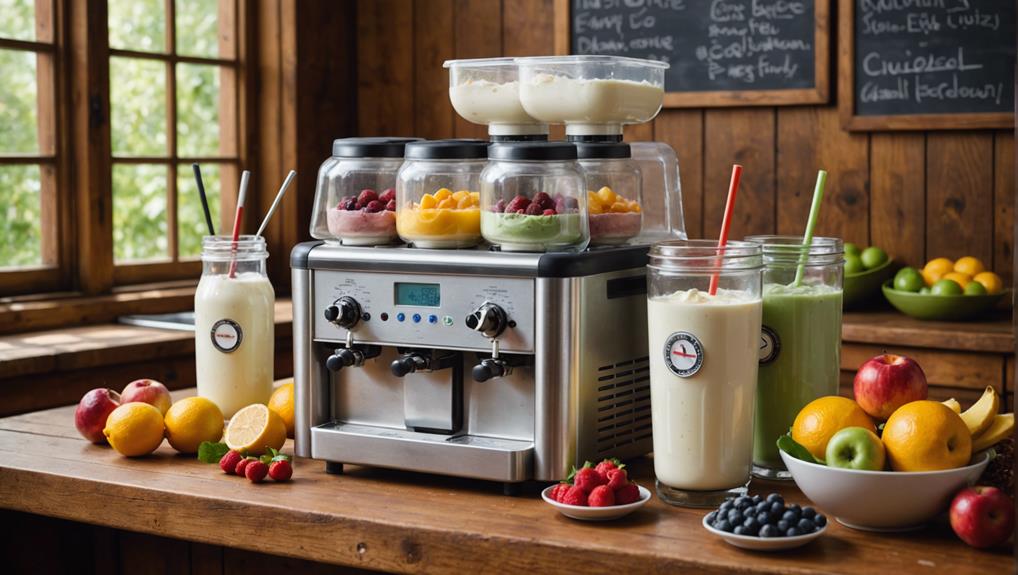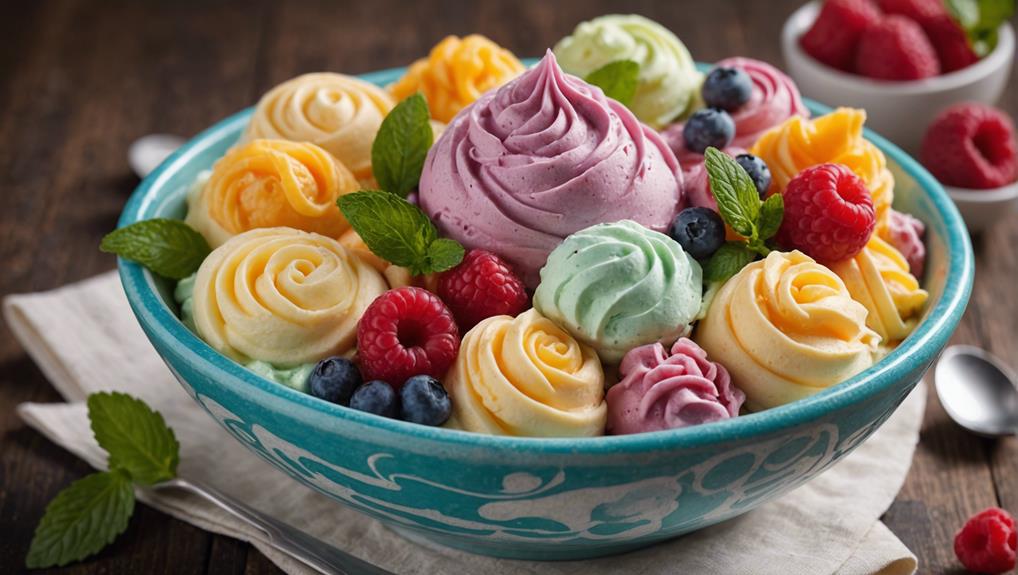Freezing point depression is essential to the texture of frozen yogurt. By adding solutes like sugar or salt, the freezing point is lowered, disrupting the water's lattice structure to prevent large ice crystal formation. This results in a smoother, creamier consistency. Precise control of solute concentrations is important to achieve the desired texture and quality. Sweeteners and salts not only lower the freezing point but also enhance overall mouthfeel and sensory experience. Proper balance and understanding of these ingredients are critical. Further exploration into the impact of these factors will reveal deeper insights into achieving perfect frozen yogurt.
Key Takeaways
- Addition of solutes like sugar lowers the freezing point of frozen yogurt.
- Solutes disrupt the regular lattice structure of water, preventing large ice crystal formation.
- Controlled solute concentration is crucial for achieving a smooth, creamy texture.
- Sugar and salt both contribute to freezing point depression, enhancing mouthfeel.
- Proper use of stabilizers and emulsifiers ensures a consistent texture by preventing ice crystal growth.
Understanding Freezing Point Depression

How does the addition of solutes like sugar or alcohol result in the phenomenon known as freezing point depression in frozen yogurt? Freezing point depression occurs when solutes are introduced into a solvent, lowering the temperature at which the solvent solidifies. In the context of frozen yogurt, adding sugar or alcohol modifies the freezing dynamics of the yogurt mixture. This is primarily due to the fact that these solutes interfere with the formation of ice crystals by disrupting the regular lattice structure that water molecules form as they freeze.
The presence of sugar or alcohol in frozen yogurt lowers the mixture's freezing point, resulting in a smoother and creamier texture. This is because the formation of large ice crystals is inhibited, which would otherwise lead to a grainy texture. By precisely controlling the concentration of sugar or alcohol, manufacturers can achieve the desired consistency and quality. This control is vital for maintaining the structural integrity of frozen yogurt, enhancing its sensory attributes such as mouthfeel and palatability.
Understanding freezing point depression and its implications allows frozen yogurt makers to create a product that delivers excellent texture and flavor, ensuring a superior consumer experience.
Role of Solutes in Freezing Point
The inclusion of solutes such as sugar or alcohol into frozen yogurt mixtures plays an important role in modulating the freezing point of the product. These solutes induce freezing point depression, a phenomenon where the presence of solute particles in a solution lowers its freezing point relative to the pure solvent. In the context of frozen yogurt, this effect is essential for preventing the formation of large ice crystals, which can adversely affect the texture.
By lowering the freezing point, solutes help to ensure that the frozen yogurt remains smooth and creamy rather than icy. The degree of freezing point depression is directly related to the concentration of solutes in the mixture; higher concentrations lead to greater depression of the freezing point. This controlled manipulation of the freezing point is necessary for achieving the desired texture in frozen yogurt, as it allows for a more consistent and palatable product.
Moreover, understanding the role of solutes in this process enables manufacturers to fine-tune their recipes to optimize texture. Consequently, the strategic use of solutes is a key element in the production of high-quality frozen yogurt, ensuring a product that is both appealing in texture and satisfactory in mouthfeel.
Impact of Sugar on Yogurt Texture

The incorporation of sugar into frozen yogurt formulations is crucial for modifying its consistency and mouthfeel. By lowering the freezing point, sugar disrupts ice crystal formation, thereby enhancing creaminess and reducing grittiness. Ideal sugar levels not only improve texture but also contribute to the overall sensory experience.
Sugar's Role in Consistency
Sugar fundamentally alters the consistency of frozen yogurt by lowering its freezing point, thereby preventing the formation of large ice crystals and guaranteeing a smooth texture. The role of sugar in this scenario is multifaceted; primarily, it acts as a freezing point depressant. By reducing the temperature at which the yogurt mixture solidifies, sugar inhibits the development of large ice crystals, which would otherwise compromise the desired creamy consistency.
The precise amount of sugar incorporated into frozen yogurt recipes is crucial. A perfect concentration of sugar not only lowers the freezing point but also ensures that the mixture remains pliable and easy to scoop. This balance is essential for achieving a product that is both smooth and creamy. Conversely, insufficient sugar levels can result in a harder texture and larger ice crystal formation, detracting from the overall sensory experience.
Moreover, the quality of frozen yogurt is intrinsically tied to the control of its freezing dynamics. By carefully regulating the sugar content, manufacturers can adjust the physical properties of the final product, thus enhancing its market appeal. To sum up, sugar's role in frozen yogurt is indispensable for attaining a superior texture through precise control of freezing point depression and ice crystal inhibition.
Sweeteners and Mouthfeel
While the role of sugar in freezing point depression is well-established, it is also imperative to understand how various sweeteners influence the mouthfeel and overall texture of frozen yogurt. The sugar content directly impacts the freezing point depression, which in turn affects the texture. Higher sugar concentrations generally yield a smoother and creamier product due to the reduction in ice crystal formation.
Different sweeteners, such as sucrose and glucose, exhibit varying effects on the freezing point depression and texture. For instance, sucrose is known for its moderate impact on freezing point depression, leading to a balanced texture, while glucose, with a higher freezing point depression, results in a softer and less icy mouthfeel. Balancing sugar levels is essential to avoid undesirable textures, such as iciness or graininess, which can detract from the consumer experience.
| Sweetener | Impact on Freezing Point Depression |
|---|---|
| Sucrose | Moderate |
| Glucose | High |
| Fructose | Very High |
| Lactose | Low |
| Maltose | Moderate |
Understanding the interaction between sweeteners and freezing point depression is essential for achieving the ideal mouthfeel in frozen yogurt. This balance ensures a product that is both enjoyable and texturally appealing.
Salt's Contribution to Creaminess
Incorporating salt into frozen yogurt formulations effectively lowers the freezing point, thereby enhancing creaminess by inhibiting large ice crystal formation. This phenomenon, known as freezing point depression, is critical for achieving a smooth and velvety texture. When salt is added, it disrupts the orderly structure of water molecules, requiring a lower temperature to form solid ice crystals. This process not only prevents the formation of large, disruptive ice crystals but also guarantees a more consistent and desirable mouthfeel.
The role of salt in frozen yogurt is analogous to the use of sugar, as both ingredients lower the freezing point of the mixture. However, salt is particularly effective because it dissociates into ions, which have a pronounced effect on freezing point depression. The resulting lower temperature environment curtails the growth of ice crystals, ensuring a fine, even distribution throughout the yogurt matrix.
Understanding the precise impact of salt on the freezing dynamics is essential for producers aiming to create high-quality frozen yogurt. By meticulously controlling the salt content, manufacturers can optimize the texture, thereby enhancing the overall sensory experience for consumers. In sum, salt is indispensable in the quest for creaminess in frozen yogurt production.
Equipment Needed for Frozen Yogurt

Achieving the ideal texture and creaminess in frozen yogurt not only relies on ingredient selection but also necessitates the use of specific equipment designed to control temperature and consistency. Central to this process is a yogurt maker or an ice cream machine, both of which facilitate the freezing and churning necessary to disperse water molecules uniformly and prevent the formation of large ice crystals. This is vital for guaranteeing that the final product remains smooth and creamy.
Supplementary equipment includes blenders and mixing bowls, which are essential for homogenizing ingredients such as heavy cream and yogurt cultures before the freezing stage. Accurate temperature monitoring is supported by thermometers, which are indispensable during the yogurt fermentation process. This precision ensures that bacterial cultures develop appropriately, impacting the texture and flavor of the frozen yogurt.
Additional tools such as strainers or cheesecloths serve to remove excess liquid from the yogurt, enhancing its consistency before it is frozen into yogurt. Measuring cups and spoons aid in the precise quantification of ingredients, contributing to the consistent quality of the product. Finally, spatulas and storage containers are necessary for transferring and storing the finished frozen yogurt, maintaining its integrity until consumption.
Ingredients for Perfect Consistency
To achieve the ideal consistency in frozen yogurt, it is essential to take into account the roles of essential dairy components, sweeteners, and the interplay of stabilizers and emulsifiers. Yogurt cultures and milk solids provide the foundational texture, while sweeteners adjust the freezing point depression. Emulsifiers and stabilizers, such as lecithin and guar gum, guarantee a smooth texture and prevent ice crystal formation, thereby optimizing the overall structure.
Essential Dairy Components
The creamy consistency of frozen yogurt is primarily influenced by its high protein content, live bacterial cultures, milk fat, sweeteners, and emulsifiers. These components work synergistically to create a product that is both palatable and structurally stable.
Firstly, the milk fat content greatly impacts the richness and mouthfeel of frozen yogurt, providing a smooth and luxurious texture. Lower water content in the formulation is essential, as excess water can lead to the formation of ice crystals, adversely affecting the product's consistency. High protein content, derived from the yogurt itself, contributes to the overall creaminess and viscosity, offering resistance to melting.
Additionally, sweeteners play a dual role. Not only do they enhance flavor, but they also contribute to freezing point depression, which is vital in maintaining a soft, scoopable texture even at low temperatures.
Live bacterial cultures are indispensable for fermentation, adding a characteristic tanginess and enhancing the nutritional profile. Finally, emulsifiers stabilize the mixture, ensuring uniform distribution of fat and other ingredients, preventing separation.
Key dairy components include:
- Milk fat content
- Water content
- High protein content
- Live bacterial cultures
- Emulsifiers
Understanding these elements is essential for achieving the perfect consistency in frozen yogurt.
Sweeteners and Their Role
Sweeteners not only enhance the flavor profile of frozen yogurt but also play a crucial role in modulating its freezing point and texture. The choice of sweeteners such as sugar, honey, and agave syrup has a substantial impact on freezing point depression. This phenomenon, whereby the presence of solutes lowers the freezing point of a liquid, is critical in achieving a smooth, creamy texture in frozen yogurt.
Sugar content is a primary determinant in the formation and size of ice crystals within the yogurt mixture. High sugar content results in smaller ice crystals, which contribute to a finer texture and a more pleasant mouthfeel. It is essential to meticulously balance the amount of sweetener to avoid an overly soft or excessively hard product.
Moreover, the different sweeteners have varying impacts on freezing point depression. For instance, honey and agave syrup, which contain additional sugars like fructose, may lower the freezing point more effectively than sucrose alone. Understanding the specific properties and effects of each sweetener allows for precise control over the texture and consistency of the finished product, thereby enhancing the sensory experience of frozen yogurt.
Stabilizers and Emulsifiers
Stabilizers and emulsifiers are essential components that guarantee frozen yogurt maintains its desired consistency and texture throughout production, storage, and consumption. These ingredients play a pivotal role in ensuring that frozen yogurt, much like ice cream contains, remains smooth and creamy without compromising on quality.
Stabilizers, such as guar gum and carrageenan, are instrumental in preventing the formation of ice crystals, which can negatively impact the texture of frozen yogurt. By inhibiting ice crystal growth, stabilizers help maintain a uniform and appealing consistency. Emulsifiers like lecithin are equally critical, as they facilitate the blending of fat and water, creating a stable emulsion that contributes to the creamy texture characteristic of high-quality frozen yogurt.
The benefits of incorporating stabilizers and emulsifiers include:
- Improved texture: They prevent ice crystal formation, ensuring a smooth and creamy product.
- Enhanced shelf life: They help maintain the product's quality over time.
- Consistent quality: They ensure uniformity in texture and structure during storage and serving.
- Optimal mouthfeel: They contribute to the desirable creamy texture.
- Efficiency in production: They ensure a more reliable and repeatable manufacturing process.
Incorporating stabilizers and emulsifiers properly is paramount for achieving and maintaining the desirable texture and consistency in frozen yogurt.
Step-by-Step Preparation Guide

To achieve a smooth and creamy frozen yogurt, start by preparing the yogurt base with a mixture of milk, yogurt cultures, and added sugars to lower the freezing point. This initial step is essential for making ice cream-like consistency in frozen yogurt, as the added sugars disrupt the water freezing process, resulting in a softer texture. Additionally, the fat content in the milk should be carefully considered, as it contributes to the overall mouthfeel and creaminess of the final product.
Begin by heating the milk to approximately 85°C to denature the proteins, ensuring a stable yogurt culture environment. After cooling to 43°C, introduce the yogurt cultures and maintain this temperature for fermentation. Once the yogurt base is ready, incorporate sugars and any other sweeteners, which will further depress the freezing point, ensuring a pliable end product.
Next, add stabilizers such as guar gum or carrageenan. These ingredients play a critical role in inhibiting large ice crystal formation, a common challenge in frozen yogurt production. Properly churning the mixture is essential; it incorporates air and maintains small ice crystal size, producing a velvety texture. Finally, freeze the mixture under controlled conditions to achieve the desired consistency.
Troubleshooting Common Issues
Addressing common issues in frozen yogurt production requires a detailed understanding of ingredient interactions and processing techniques. Common problems such as icy texture, graininess, and lack of creaminess can have a notable impact on the quality of the final product.
To mitigate icy textures, adjust sweetener and stabilizer levels to prevent large ice crystal formation. Graininess often results from improper mixing or ingredient incorporation, necessitating a review of mixing protocols to guarantee uniform distribution. A lack of creaminess could be indicative of insufficient fat content or inadequate churning during production, issues that can be resolved by incorporating ingredients that offer a higher fat content, such as whipped cream, or by refining churning processes to align with those used in producing ice cream without these problems.
Below are some targeted strategies to troubleshoot these issues:
- Preventing icy texture: Adjust sweeteners and stabilizers to control ice crystal size.
- Reducing graininess: Improve mixing techniques to ensure even ingredient distribution.
- Enhancing creaminess: Increase fat content using ingredients like whipped cream.
- Optimizing churning: Refine churning techniques to enhance texture and consistency.
- Managing water content: Formulate recipes with less water to prevent dilution and improve texture.
Enhancing Flavor and Texture

Enhancing the flavor and texture of frozen yogurt involves a crucial selection of ingredients and meticulous processing techniques to achieve a superior product. Incorporating fruit purees and flavorings not only elevates the taste but also contributes to the textural complexity. Utilizing natural sweeteners such as honey or agave syrup can enhance the flavor profile, while maintaining a balance between sweetness and acidity.
The choice of high-quality yogurt with live cultures is essential, as it imparts a tangy and creamy texture, elevating the overall sensory experience. Experimenting with various mix-ins like nuts, chocolate chips, or cookie pieces introduces diverse textures, making the frozen yogurt more appealing.
| Ingredient | Impact on Flavor and Texture |
|---|---|
| Fruit Purees | Enhances taste, adds natural sweetness |
| Natural Sweeteners | Improves flavor profile, balances acidity |
| High-Quality Yogurt | Contributes tanginess and creaminess |
| Mix-ins (Nuts, Chips) | Adds texture and flavor complexity |
| Added Sugar | Balances acidity, affects freezing point |
Balancing the yogurt's acidity with sweeteners and toppings is crucial for an expertly crafted frozen yogurt. The presence of added sugar and fat in ice influences the freezing point, aiding in the production of an exceptionally smooth texture similar to that of make ice cream. Through these meticulous choices, one can create a frozen yogurt that is both flavorful and texturally pleasing.
Frequently Asked Questions
What Is the Freezing Point Depression of Ice Cream?
The freezing point depression of ice cream, typically around -18 degrees Celsius, results from colligative properties. Increased solute concentration, such as sugars or alcohols, lowers the freezing point, leading to significant temperature reduction essential for ideal texture.
What Are Some Examples of Freezing Point Depression in Real Life?
As the saying goes, "Necessity is the mother of invention." Examples of freezing point depression in real life include road salting to prevent ice formation, antifreeze usage in engines, and alcohol freezing in beverages to maintain liquid state.
What Is Freezing Point Depression in Food?
Freezing point depression in food involves lowering the freezing point by adding solutes, leveraging the cryoscopic constant. This effect is essential for food preservation, as it prevents large ice crystal formation, ensuring ideal texture and quality.
What Is the Freezing Point of Soft Serve Ice Cream?
The freezing point of soft-serve ice cream, a marvel of ingredient composition, typically ranges between -3 to -5 degrees Celsius. Precision in temperature control and the inclusion of dairy alternatives profoundly influence its desired creamy texture and consistency.
Conclusion
In summary, the phenomenon of freezing point depression plays a critical role in the texture and quality of frozen yogurt. The introduction of solutes, particularly sugars and salts, greatly alters the freezing characteristics, enhancing creaminess and consistency. Proper equipment and precise ingredient measurements are essential to achieve the best results. Addressing common issues and meticulous preparation ensures superior flavor and texture. Mastering these elements is akin to crafting a flawless phonograph record in the domain of frozen desserts.







